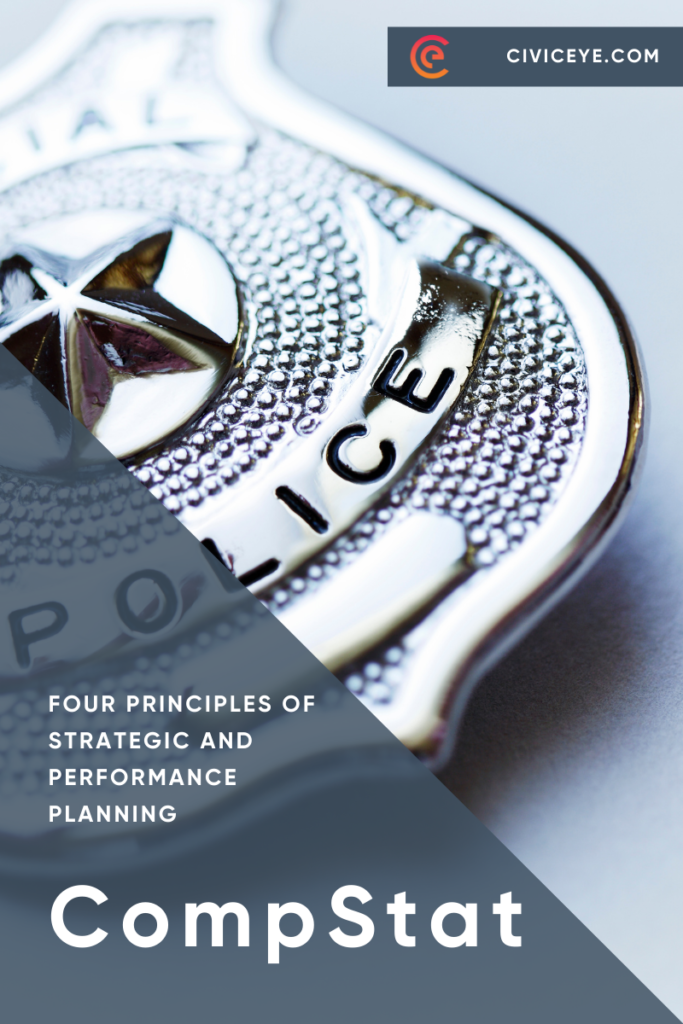Modern policing tactics have continued to progress with the evolution of technology. From the creation of the National Crime Information Center (central database for tracking crime-related information) in 1967 to the use of DNA forensic testing in 1987, applying data and research to improve the effectiveness in policing practices is one of the reasons CompStat is a model for strategic problem-solving for law enforcement.
Understanding ‘what is CompStat’, the principles of CompStat, and how the principles apply to policing methods is essential to continue improving and reflecting on the effectiveness of current tactics while achieving goals to improve public safety in communities across the United States.
What is CompStat?
CompStat is a tool that empowers police officers to enact a form of strategic planning, management of data, and leadership to promote accurate and timely intelligence, effective tactics, rapid deployment, and relentless follow-up and assessment. Developed by Jack Maple and Bill Bratton from NYPD in the early 1990s, CompStat is a performance management system that advanced the ways police officers would track crime through computer-generated statistics (CompStat). It can also be derived from comparative statistics by using data and reports to find similarities and significant measures. The program’s name truly only represents a small portion of what this program was able to accomplish for policing efforts. Let’s take a quick look at each of the four principles of CompStat.

Accurate and Timely Intelligence
Police can’t hope to be at the right place at the right time to stop a crime or solve a problem. The goal of CompStat is to gather timely and accurate information and intelligence. This information (crime, traffic crash, quality-of-life data, etc.) is the number you collect and pour over, and build reports to analyze. Based on hot spots and occurrence studies, you can place your predictive modeling here. Where is my crime going to happen? Mix in all our other intelligence reports (drugs, Homeland Security, special events, etc.); there’s a lot of data. So now that we have all this data, what do we do with it?
Rapid Deployment
We need to rapidly deploy police to areas where crime is occurring. We have to get the boots on the ground as quickly as possible to address the issues we found in our intelligence data and statistics. Rapid deployment is where you look at your staffing model to determine which special teams and skillsets best address the problem while maintaining coverage throughout the jurisdiction. This may be the most challenging issue for the police leader to manage in times of reduced staffing, hiring, and retention.
Effective Tactics
Now we are going to get tactical. CompStat builds accountability into the tactical strategies and allows you to get creative and set goals for your tactics. Be sure all your officers know what the goals are and be sure your tactics address the problem; if your goal is displacement, set your tactics for that; if your goal is an arrest, set your tactics for that. We know that not all tactics work in all situations, so use your imagination, be flexible and get creative. Use what worked in the past or think of something new. If what you have done in the past isn’t working, change what you’re doing. You must identify and recognize areas of opportunity, take responsibility for decisions, and be flexible enough to change when needed! Most importantly, listen to your officers. They are the ones working on the problem, and they have firsthand knowledge. Empower them. Trust them. Each individual involved in the plan should have accountability.
Relentless Follow-up and Assessment
The final aspect of CompStat is the relentless follow-up and assessment, where you can look at what’s working and what’s not and have the flexibility to change. If the essence of CompStat is to address the problem by coming up with a plan, ask yourself, “Did the plan meet and accomplish our goal? If not, why not? Should the plan be changed or repeated?”
CompStat meetings keep leaders abreast with situations happening among their teams and enhance accountability. Sure, it can be a very uncomfortable place to be. Picture this: you are a high-level commander, and you’re in a room full of peers being grilled on your crime numbers and what you have done to address the issues. All the issues and problems are on you, and you have the ultimate responsibility. There is a benefit to sharing transparency and having open discussions on how our strategy and plan worked. How do we know what’s working and what isn’t? We must go back to step one, accurate, timely intelligence. Yes, CompStat is just one big circle.
Final Thoughts
CompStat is just one version of strategic planning, leadership, and management. Jack Maple took the idea from how Great Britain used radar to track Nazi bombers during WWII and turned it into a crime-fighting model for modern policing. What’s important to remember about CompStat is the principles outline approaches to help you look at the statistics you collect, make decisions on the data, and learn how your tactics and strategies help you overcome challenges.
CivicEye clients collect a trove of valuable, actionable data and intelligence. Let us know what we can do to help make data entry easier through integrations with CAD and RMS, improve your incident report validations with NIBRS and ultimately give you the tools you need to serve your community. To learn more about CivicRMS and schedule a demo, click here.
For more information on CompStat, check out these other helpful resources:

